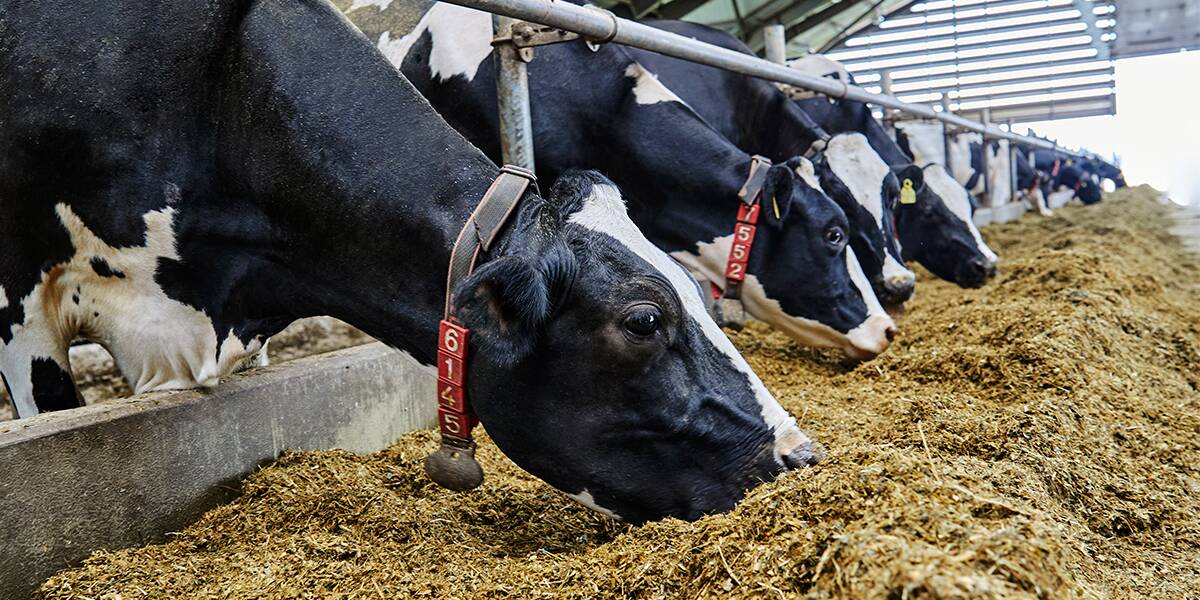Selecting dairy sires to optimise feed efficiency

This is branded content for VikingGenetics
Paying more attention to feed efficiency indexes when selecting sires for dairy herds will help compensate for the escalating costs of feed being witnessed today.
With that in mind dairy farmers are being urged to consider all options to help mitigate these high costs and one perfect tool for doing so is a more targeted and efficient use of genetics.
Two Holstein cows with the same production level may have quite different feed intake levels.
Research showed in one case the more efficient cow consumed 861 kilograms less dry matter than the other cow, which corresponds to a 12 per cent reduction in feed costs.
What is the feed efficiency index?
By selecting genetics with a high index for feed efficiency dairy farmers can use sires that breed cows as better feed converters.
This means cows produce more milk and meat on less feed and at the same time ensure that cows have good health and reproduction performance, and long productive life.
That helps improve the profitability and sustainability of the business.
The feed efficiency index shows how efficient a cow is in turning feed into milk. While some cows are good at this, others use too much feed for maintenance and are less efficient when it comes to utilising the feed.
The development of a reliable index for feed efficiency requires direct and accurate measurements of individual cow's feed intake in a large number of lactating cows under the conditions in which they are expected to perform.
The cows sired by the bulls with a high index for feed efficiency use fewer feed resources, as they convert feed more efficiently and require less energy for maintenance.
That means the resources are used more efficiently and dairy farmers can produce more milk and meat with fewer inputs reducing the environmental impact.

Decoding feed efficiency indexes - five critical questions for informed decision-making
There are five straight questions a farmer should ask his or her genetics rep when considering feed efficiency indexes.
- Is the data collected from commercial herds with different production systems and management levels without disturbing cows' natural behaviour and daily routines on the farm?
Herds have different production systems and management levels therefore the data should be collected from a number of farms to give a more reliable index.
- Is the data on feed intake collected on lactating cows?
Some genetic companies offer data collected from heifers. Research from Pryce et al in 2014 reported a genetic correlation of 0.67 between heifer and first lactation cow efficiency. This means that heifer efficiency only explains 45pc of the variation in cow efficiency. This makes the value of making heifer registrations to predict cow efficiency very inefficient.
- Is the feed intake measured throughout the whole lactation and over the cow's lifetime?
A cow's physiology and production changes dramatically through lactations. Feeding requirements and performance varies for different periods in lactation. Therefore data should be collected from various stages of the cow's life.
- Does the index allow breeding for better feed efficiency without the negative impact on production, health and fertility?
Breeding solely to save feed is not enough as production levels need to be sustained to secure farm's profits. When breeding for more feed efficient cows farmers need to be careful and not favour the cow that depletes its body reserves for milk production.
- Does the feed efficiency index account for metabolic efficiency?
Metabolic efficiency is a crucial element in feed efficiency as it measures how efficient the cow is in converting feed energy in her body. This is energy used for instance for supporting milk production.

Feed efficiency index advantages
Breeding for higher feed efficiency helps reduce the environmental impact of dairy and beef industries, as more feed efficient cows have lower methane emissions.
It is important to reduce the environmental impact that each dairy farm has. And if the farmer can achieve this by making relatively simple change in the genetics that they use in the herd in order to reduce the amount of feed that cows intake, and reduce the amount of waste produced but still maintain the desired production level, that results in more efficient farming.
Jan Lassen, MSc., PhD, and Senior Research Manager at the Nordic genetics company VikingGenetics owned by the cattle breeders in Denmark, Sweden and Finland, is encouraging farmers to consider the value of Saved Feed Index that is part of Nordic Total Merit index.
"Breeding for improved efficiency is a win-win situation. Higher production occurs when we select the most efficient animals," Mr Lassen said.
"There are no negative consequences on health, reproduction and longevity traits."
The Saved Feed Index is based on data from the Cattle Feed Intake System (CFIT), a state-of-the-art system where three dimensional cameras and artificial intelligence are used to identify the cows, estimate their weight, and quantify how much they eat.
Backed by more than nine years of research and development, CFIT provides real-life data for individual cow's feed intake collected in the cow's natural environment year round.
- 1,300,000+ daily intake records on lactating cows
- 12,000+ cows with CFIT data
- 1,000,000+ feed visits per day
By including the Saved Feed Index into the breeding goal dairy farmers get an excellent tool to optimise their business and meet the demands for sustainable food production.
Curious about the impact of breeding? Click here for more insight.
This is branded content for VikingGenetics


